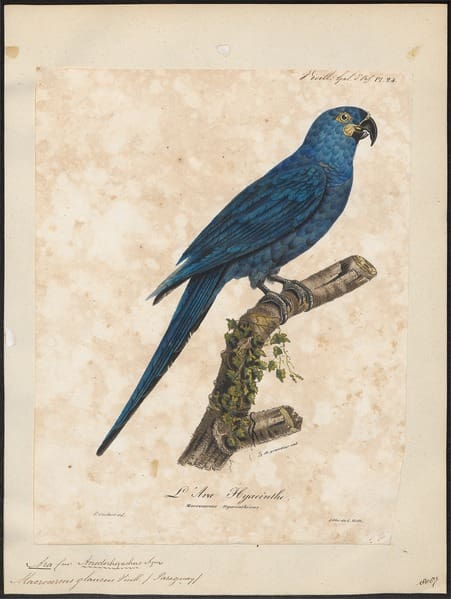
Anodorhynchus

glaucus
Size:
72 cm (28.1 in)
Weight:
Not recorded.
Subspecies including nominate:
one
Colour Adult:
Both adults green/blue, more green on underparts; grey/green tinge on head and neck; dark grey/brown throat, turning to wash on cheeks and upper breast. Beak grey/black. Eye ring bare and yellow, with paler yellow tear-drop shaped lappet at sides of lower mandible. Eye brown.
Colour Juvenile:
Not recorded.
Call:
Not recorded.
More Information:
Content Sources:
CITES
Avibase
BirdLife International
Cornell Lab of Ornithology/Birds of the World
A Guide to Parrots of the World, Juniper and Parr, 1998
Parrots of the World, Forshaw, 2006. 2010 edition
Vanished and Vanishing Parrots, Forshaw, 2017.
Lexicon of Parrots, Thomas Arndt.
Captive Status:
Last specimen in captivity died in a Buenos Aries zoo in 1938.
Longevity:
—
Housing:
—
Diet:
—
Enrichment:
—
Nest Box Size:
—
Clutch Size:
Not recorded.
Fledging Age:
—
Hatch Weight:
—
Peak Weight:
—
Weaning Weight:
—
World Population:
Unknown. Became rare by the early second half of the 19th century; there have been few reports from the 20th century. The last likely observations of the species were from Mbaracayu, Paraguay in the late 1990s and 2001. If a population remains it is likely extremely small.
IUCN Red List Status:
Critically Endangered
CITES Listing:
Appendix I
Threat Summary:
Habitat degradation and destruction due to settlement of the major river basins. Was also hunted and captured for the wild bird trade.
Range:
Formerly confined to region in middle reaches of Rio Paraguay, Rio Parana and Rio Uruguay, in SE Paraguay, NE Argentina, in Corrientes and possibly Misiones, and Rio Grande do Sul, SE Brazil; possibly also Artigas, NW Uruguay.
Habitat:
Assumed to have been found where cliff faces were available for nesting and roosting. Also a known association with riverine habitat, and sometimes lightly wooded savanna.
Wild Diet:
Fed on nuts of Butia yatay palms.
Ecology and Behaviour:
Likely gregarious.
Clutch and Egg Size:
Not recorded.
Breeding Season:
Not recorded.
Related Links:
—

![© Paul Louis Oudart [Public domain] via Wikimedia Commons An illustration depicts a Glaucous Macaw](https://parrots.org/wp-content/uploads/2023/01/wpt_Glaucous-Macaw_1301-2-100x100.jpg)